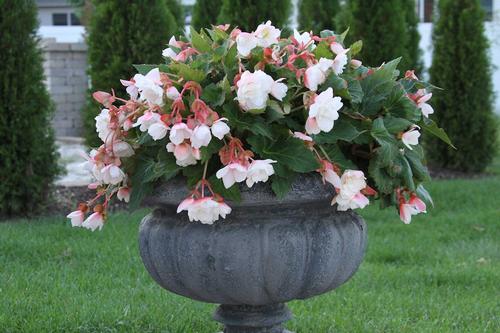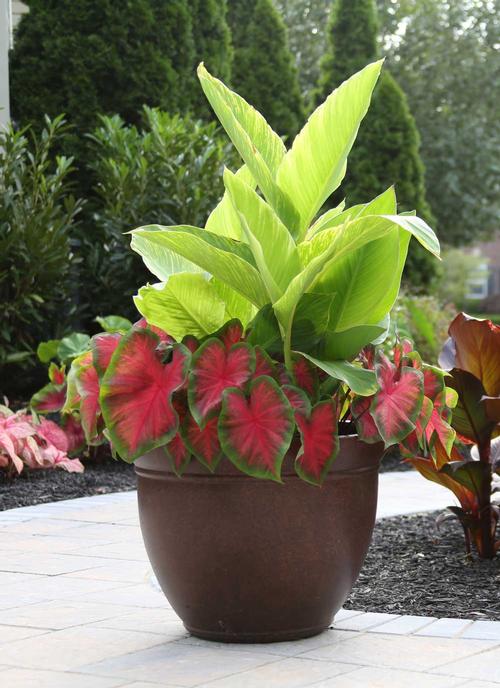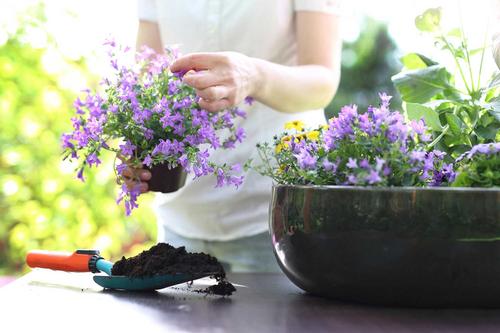6 Tips for Great-Looking Containers
Do the pots and planters around your home look as good in September as they did in June? They can -- and they should!
The show-stopping containers that you see in public gardens and urban parks don’t lose steam half way through the season. In fact, they improve. You can get the same results at home with these six tips for container gardens with staying power.
1. Start with the right size pot. Plant size should determine pot size. While a single begonia will grow well in a 1-gallon container, a 4-foot canna lily needs a pot that holds 10 times more soil. Plants get bigger, stay healthier and bloom better if their roots are not constricted. A larger pot also holds more moisture so you won’t need to water as often.
As a general rule, imagine how big the plants will be at the end of the season and choose a pot that’s about half that size. We provide a chart with the recommended bulbs per pot in this article: How to Grow Summer Bulbs in Containers.
It’s important for containers to have drainage holes so the roots can breathe and excess water will drain away. If the drainage holes are on the bottom of the pot, you can set it up on bricks or blocks of wood so the holes aren’t restricted.

2. Choose the right plants. Start with plants that will perform well in your climate and that are suited to the light conditions in your yard. Drought-tolerant plants will thrive in an arid region and sulk where it’s cloudy and wet. Sun-loving plants may not flower at all if they don’t get enough light, while direct sunlight can damage the foliage of shade loving plants. When combining a variety of plants in one container, select plants that have similar light and moisture requirements.
Don’t forget about foliage plants. They help unify a planting scheme and will give your containers a fuller look. And don’t be skimpy with plants. Containers look best when they’re filled with about twice as many plants as you would use in a garden bed.
Adding summer-blooming bulbs to your containers – on their own or mixed with other plants – ensures a long season of interest. Most of these bulbs are tropical, which means they thrive in heat and humidity. You can count on them to be hitting their stride as other plants start to fade. Here are some other plants that grow well in containers:
Annuals: coleus, petunias, fuschia, calibrachoa, marigolds, geraniums, torenia, verbena, lantana, dusty miller, helichrysum, lobelia, ageratum
Perennials: echinacea, heuchera, lavender, hostas, daylilies, salvia, astilbe, lilies, ornamental grasses, hibiscus
Summer Bulbs: begonias, caladiums, dahlias, calla lilies, cannas, elephant ears, eucomis, crinum

3. Use a quality growing mix. The soil in your containers should be light, loose, well drained and moisture-retentive. Garden soil is much too dense and may also introduce disease and insect problems. Purchase a high-quality soil-less blend made from sphagnum moss and vermiculite or perlite. Adding about finished compost will improve the texture, increase the moisture-holding capacity and add nutrients. Aim for about 20% of the mix to be compost.
Always moisten the growing mix with warm water before planting. You can put some stones in the bottom of the pot, but with a well-aerated soil mix this is unnecessary and only steals valuable root space.
Even the best soil-less mix gets compacted over time. At the start of every growing season, replace at least 50% of last year’s soil with fresh growing mix.

4. Water diligently. In most climates, container-grown plants require almost daily watering. Though they may seem to recover when you forget to water them, when the soil gets too dry, the plant’s delicate feeder roots die back. Replacing those damaged roots requires energy that would normally go into leaf and flower production.
When watering your pots and planters, take time to water deeply and thoroughly, making sure the entire root ball is soaked. To conserve moisture between watering, you can cover the soil surface with a thin layer of mulch. Clustering pots together helps protect them from drying winds, increases ambient humidity levels and will make watering easier.
5. Fertilize regularly. Even if you start the growing season with a premium soil mix that’s been enhanced with compost, those nutrients won’t be around for long. They are absorbed by plants and are also washed out of the soil by frequent watering. Attractive, long-lived container plantings need to be fertilized regularly. Apply a slow-release fertilizer (such as Osmocote) every 4-6 weeks depending on how much rain you get (more often in rainy climates). Alternatively, you can apply a water-soluble fertilizer every 2 weeks. Keep this up from May through September.
6. Primp, Prune and Replace. Go over your containers every few weeks during the growing season to remove spent flowers and cut back leggy stems. Replace tired plants with fresh plants from a nursery or your garden. Change up the look by adding some late-season favorites such as ornamental kale, asters, sedums and mums.


